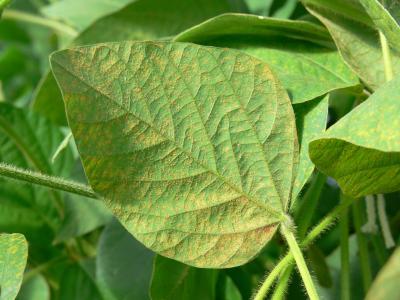When soybean rust first appeared in the United States in late 2004, many producers feared devastating yield losses similar to losses experienced in other parts of the world. In response to this threat, researchers have been evaluating USDA soybean germplasm accessions for resistance to this fungus, and a recent report in Crop Science identifies some of these resistant sources.
"Our goal was to determine which of the soybean germplasm accessions were resistant in the United States and whether they were resistant throughout the southern United States," explained David Walker, USDA-ARS scientist and assistant professor in the U of I Department of Crop Sciences. "Early on, we didn't know anything about the uniformity of the fungus populations in the mid-southern and southeastern states. It's tricky because the threat of this fungus is very dependent on weather conditions."
For example, Walker said this fungus reproduces more rapidly when temperatures are moderate and where there's abundant rainfall and heavy dew, causing spores to germinate and infect plants. The spores can move by wind and travel hundreds of miles to start a new infection, making it hard to contain.
This concern prompted field evaluations of 576 accessions from the USDA Soybean Germplasm Collection for resistance to soybean rust at seven locations in the southern United States between 2006 and 2010. Accessions were rated for disease severity in all year-location environments, and for disease incidence, fungal sporulation, lesion type, and/or uredinia density in certain environments. The Crop Science article reports the results of the 2006-2008 tests.
"While none of the accessions were immune in all environments, 64 were resistant in two or more locations each year that they were tested," Walker said. "In addition, some appeared to be more resistant in certain environments than in others."
Walker's team also included Randy Nelson and Glen Hartman of the USDA-ARS and the U of I Department of Crop Sciences, as well as collaborators from universities in Louisiana, Alabama, Georgia and South Carolina. The researchers discovered that only a subset of the soybean germplasm accessions that were resistant in South America or Africa (where soybean rust has the potential to cause up to 80 percent yield loss in some years) were resistant in the southern United States.
"The Rpp1 and Rpp3 resistance genes were found to be more effective in the United States, whereas the Rpp2 and Rpp4 genes were found to be more effective in South America," Walker said. "Nearly all of the soybean accessions that were found to be resistant to soybean rust in the United States were originally collected from southern Japan, northern Vietnam, or the island of Java (Indonesia)."

Soybean rust was first discovered in the United States in 2004. It has been known to cause up to 80 percent yield loss in some parts of the world. New research identifies resistant sources from the USDA Soybean Germplasm Collection.
(Photo Credit: David Walker, USDA-ARS and University of Illinois)
This suggests that the Brazil populations of soybean rust aren't the ancestors of the rust brought into the United States, he said. Many believed an October 2004 hurricane brought the spores from Central America or northern South America across the Gulf into the southern United States.
"It's possible it happened that way, but it seems less likely now," Walker said. "It's still a mystery how these spores got into the United States. Regardless, the soybean germplasm accessions that are resistant in South America are not necessarily resistant in the United States."
These discoveries have allowed soybean breeders to develop improved breeding lines that combine the resistance of Asian germplasm accessions with the higher yields and important agronomic traits of North American cultivars, Walker said. These lines are now being tested in the United States but are not in the public sector yet.
"It's difficult to transfer useful genes from Asian soybean types because the useful genes are often genetically linked to genes that cause problems with yield such as shattering, lodging and other undesirable traits," he said. "It takes time to transfer a piece of DNA that has a useful gene into a breeding line or cultivar adapted to the United States, then breed long enough to get rid of the undesirable genes that are linked to the useful one. We are trying to isolate the resistance genes without the undesirable genes from the same chromosome."
Currently, two cultivars are being grown in Brazil that have rust resistance, he said. Several more are under development.
"If soybean rust becomes more of a problem in the United States, we have a head start on it," Walker said. "We already have resistance in improved genetic backgrounds, so it can now be transferred more quickly into the top cultivars at any particular time."
In addition to developing rust-resistant breeding lines that are agronomically competitive, and would therefore be useful to both public- and private-sector breeders, Walker said they are interested in mapping rust resistance genes and other useful genes that are segregated in the same populations.
Source: University of Illinois College of Agricultural, Consumer and Environmental Sciences